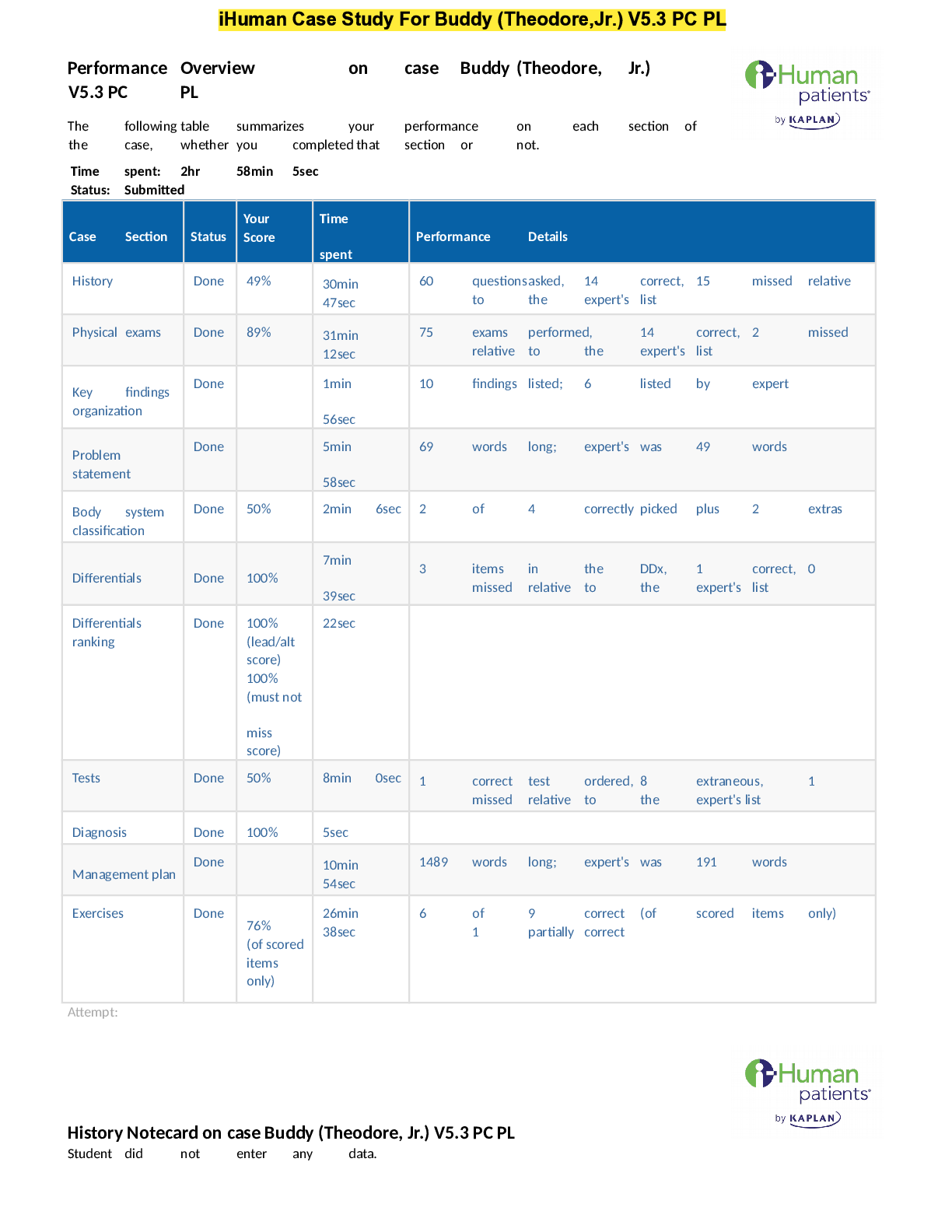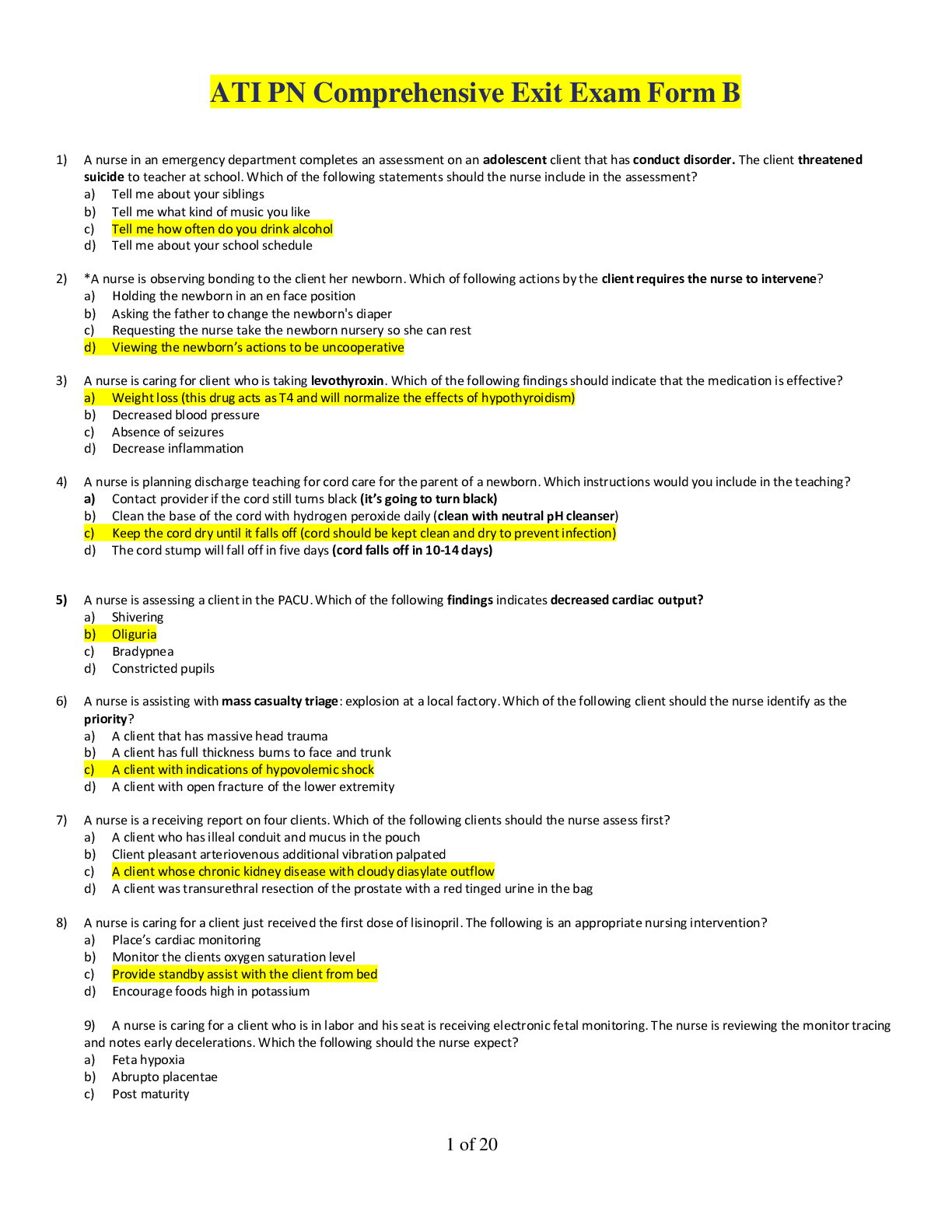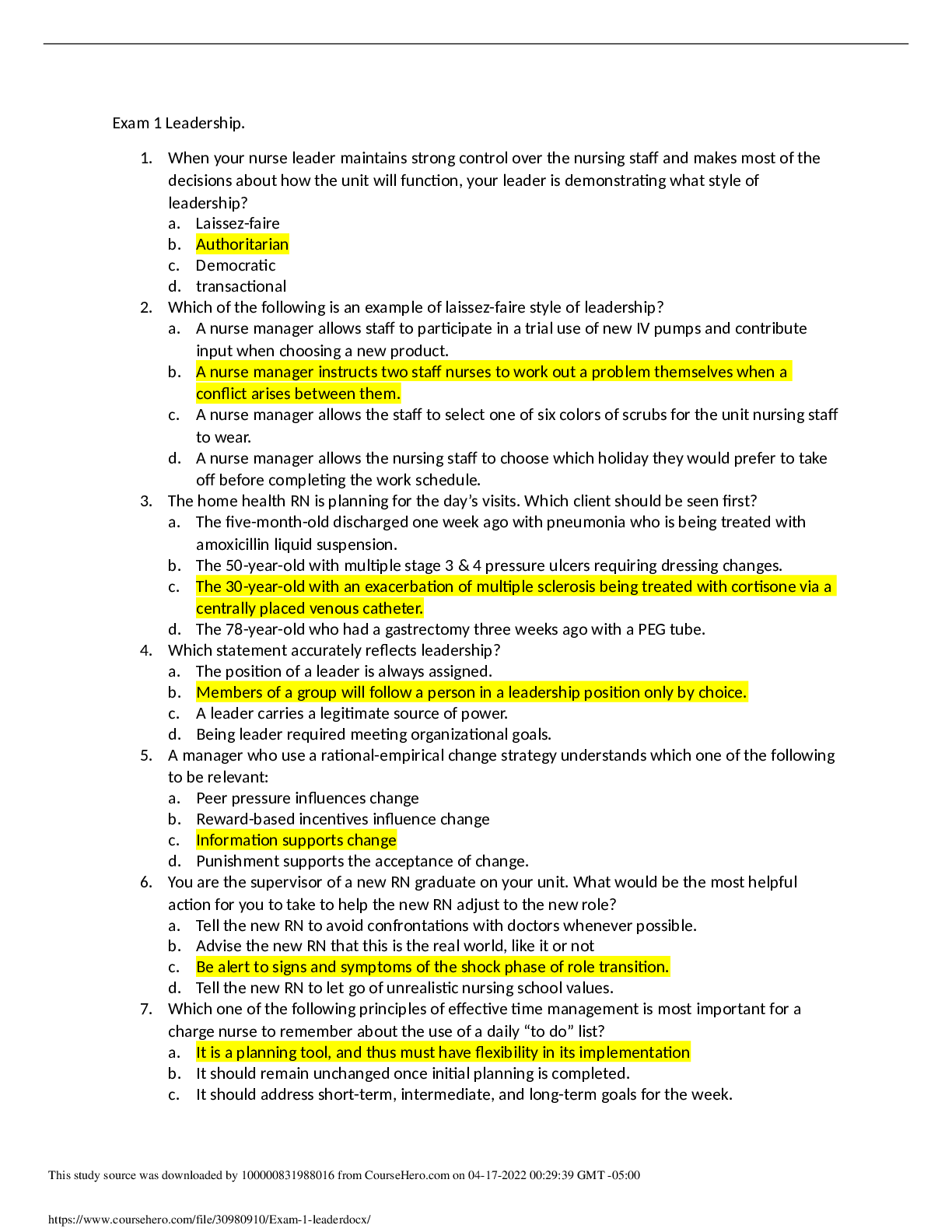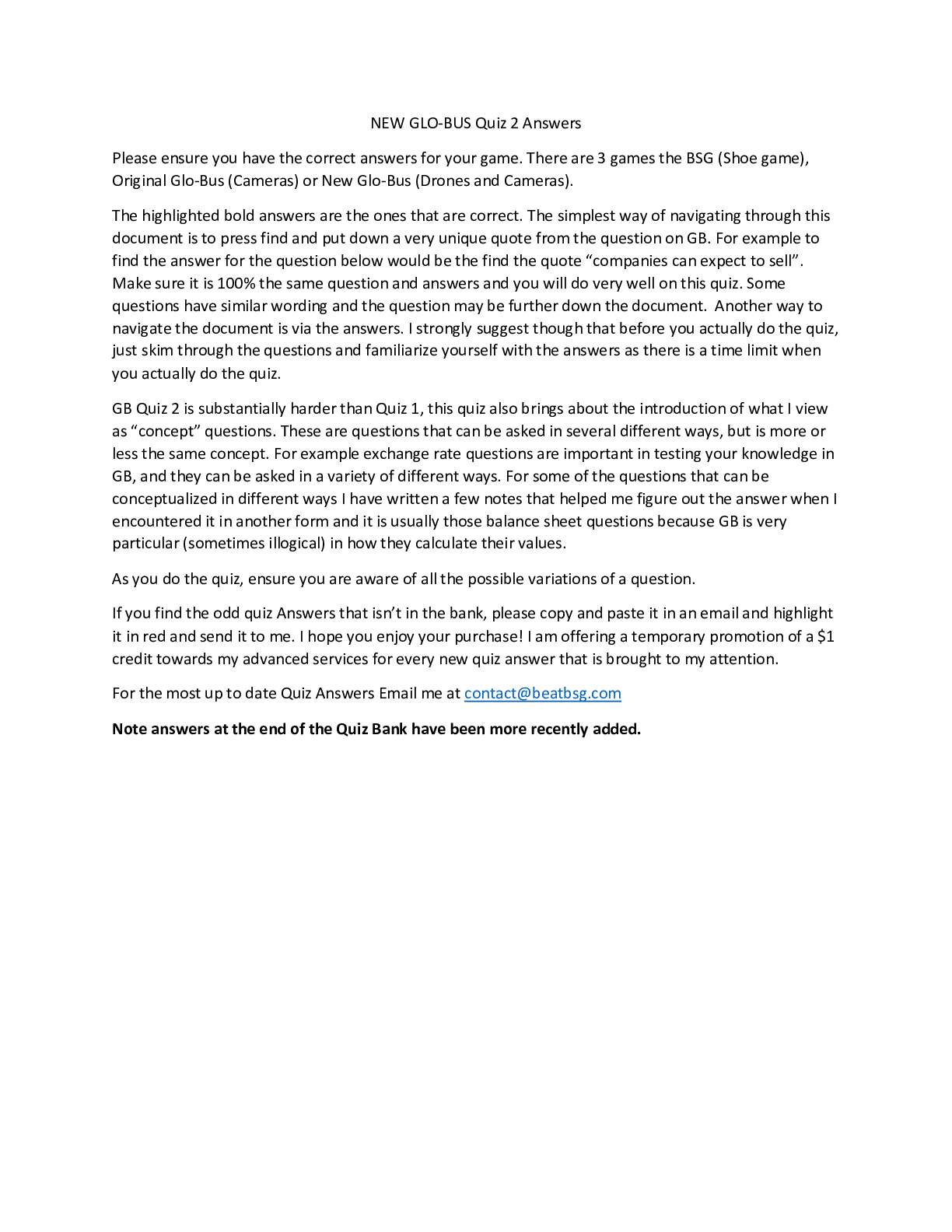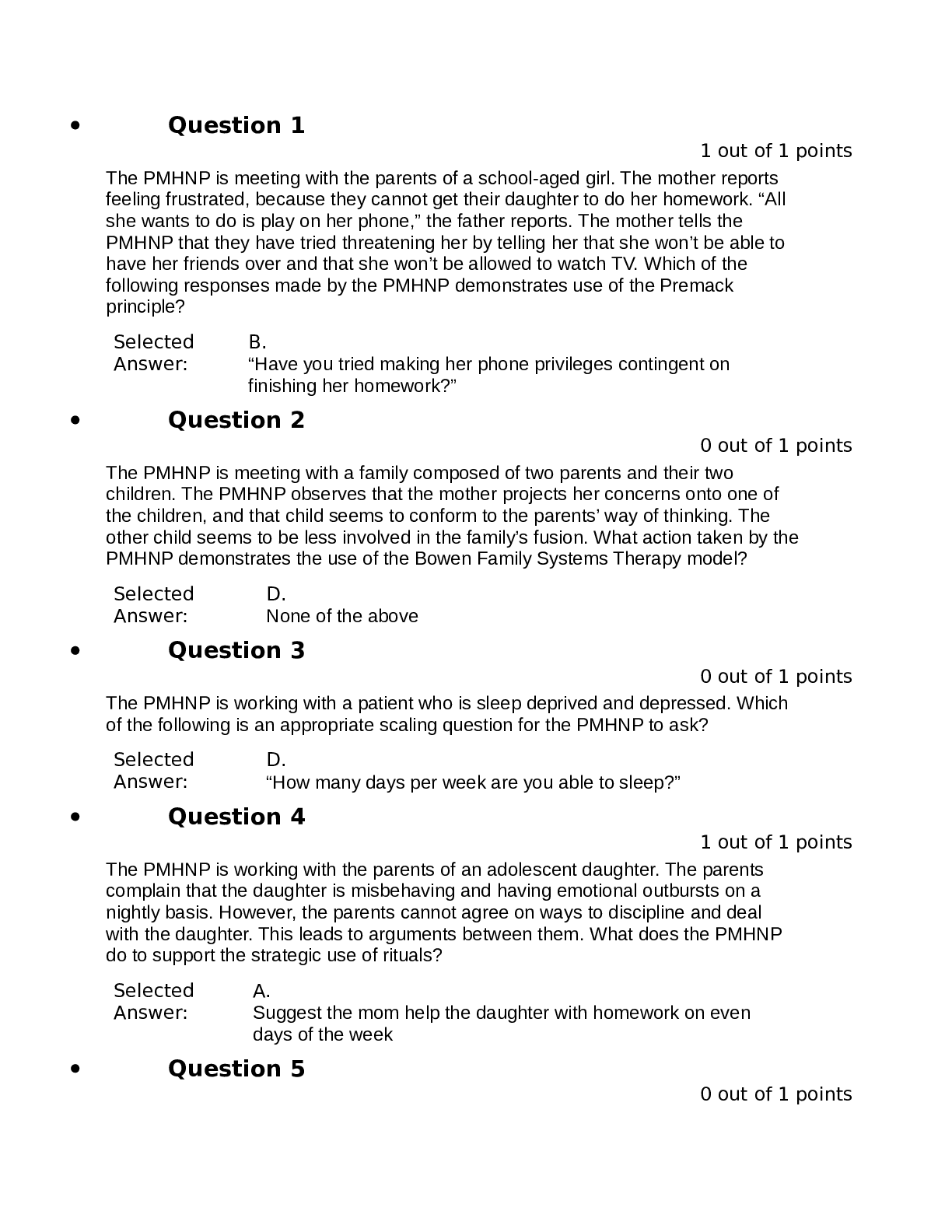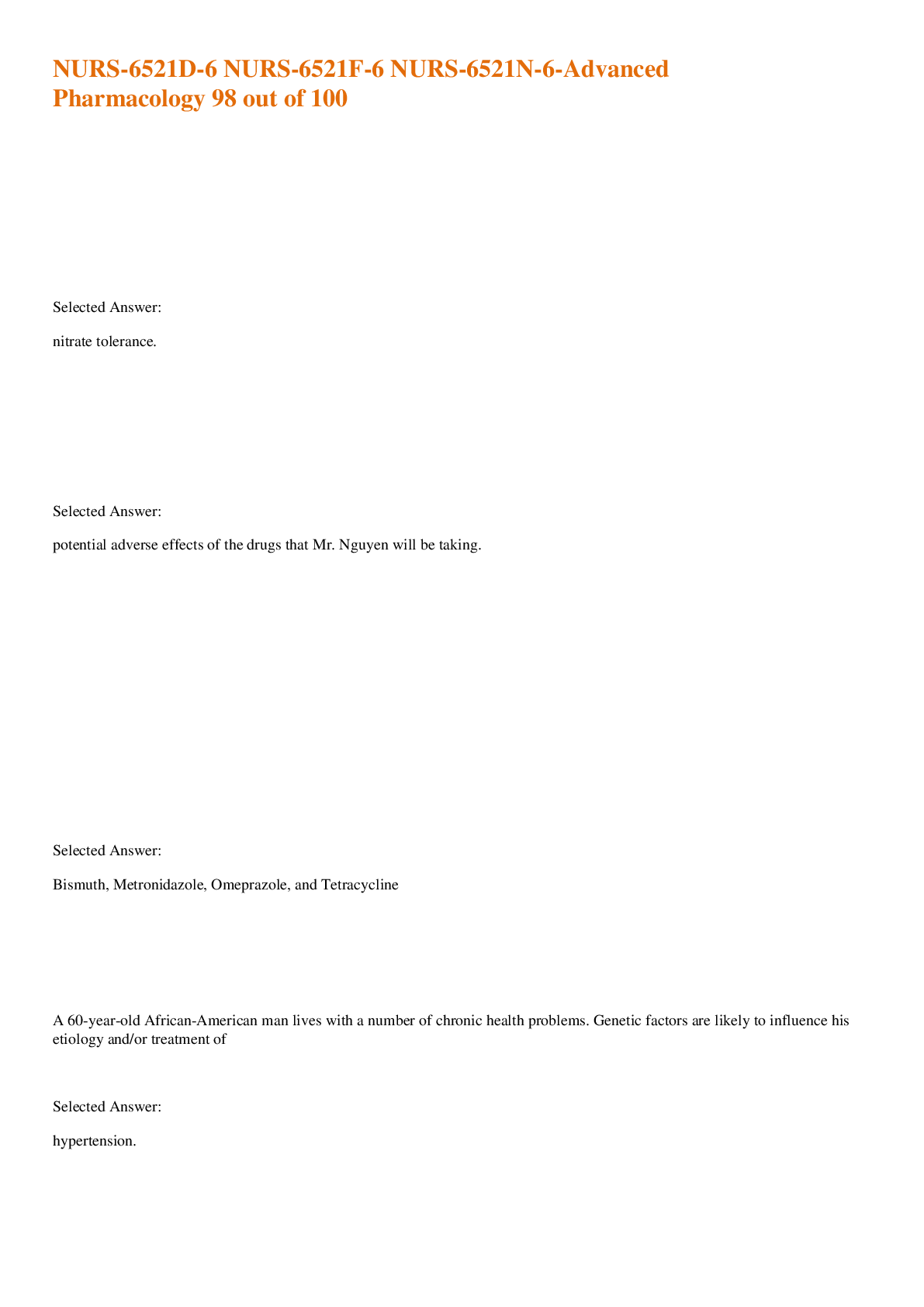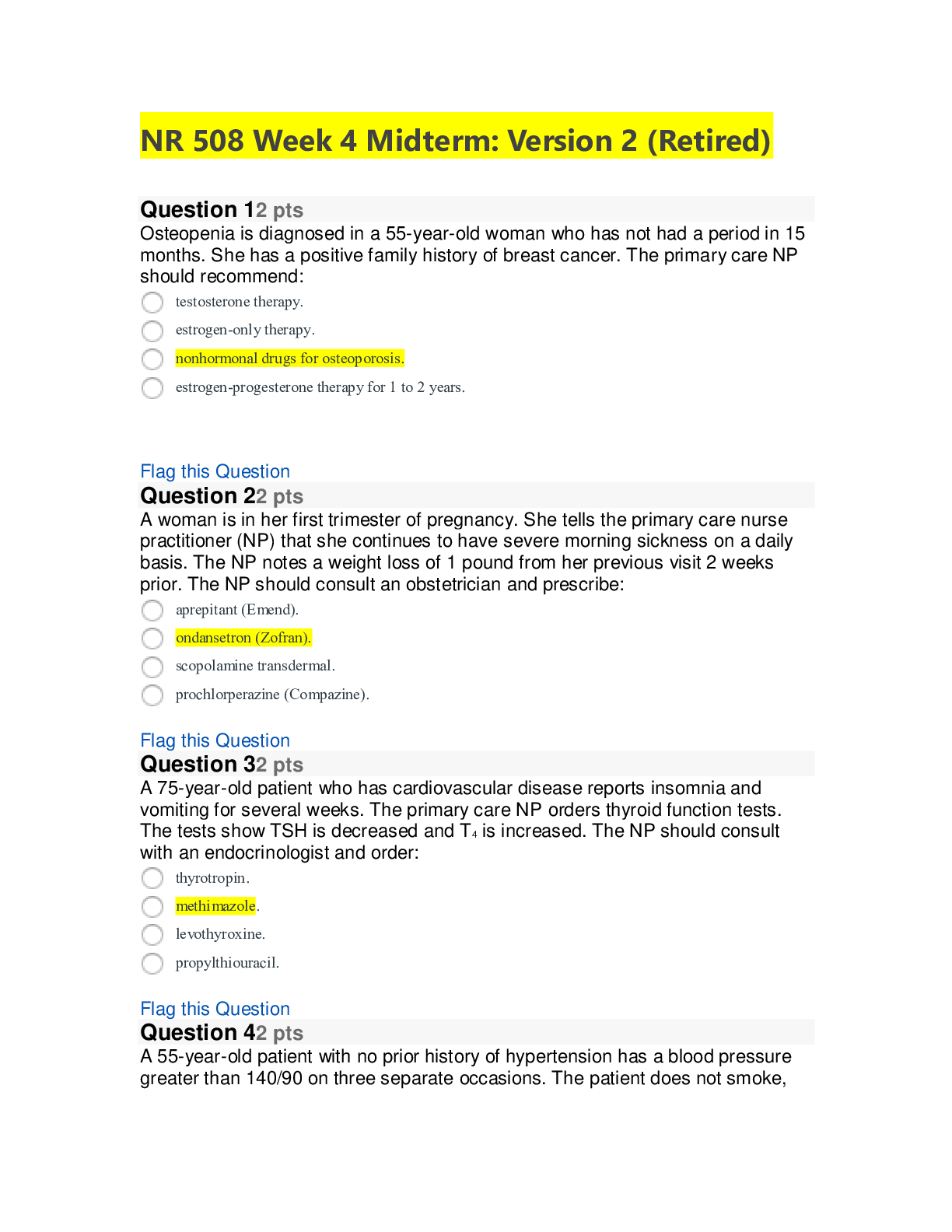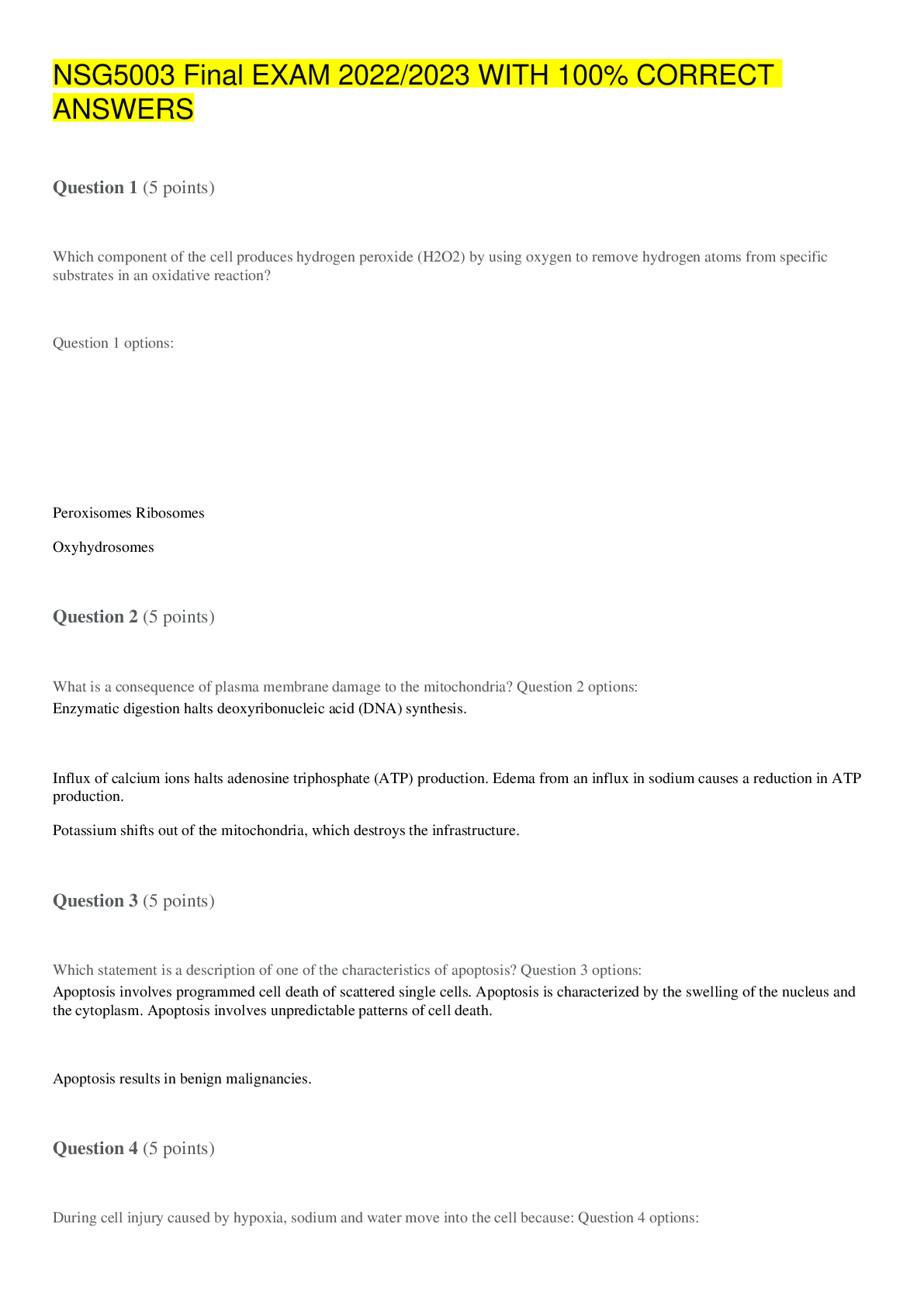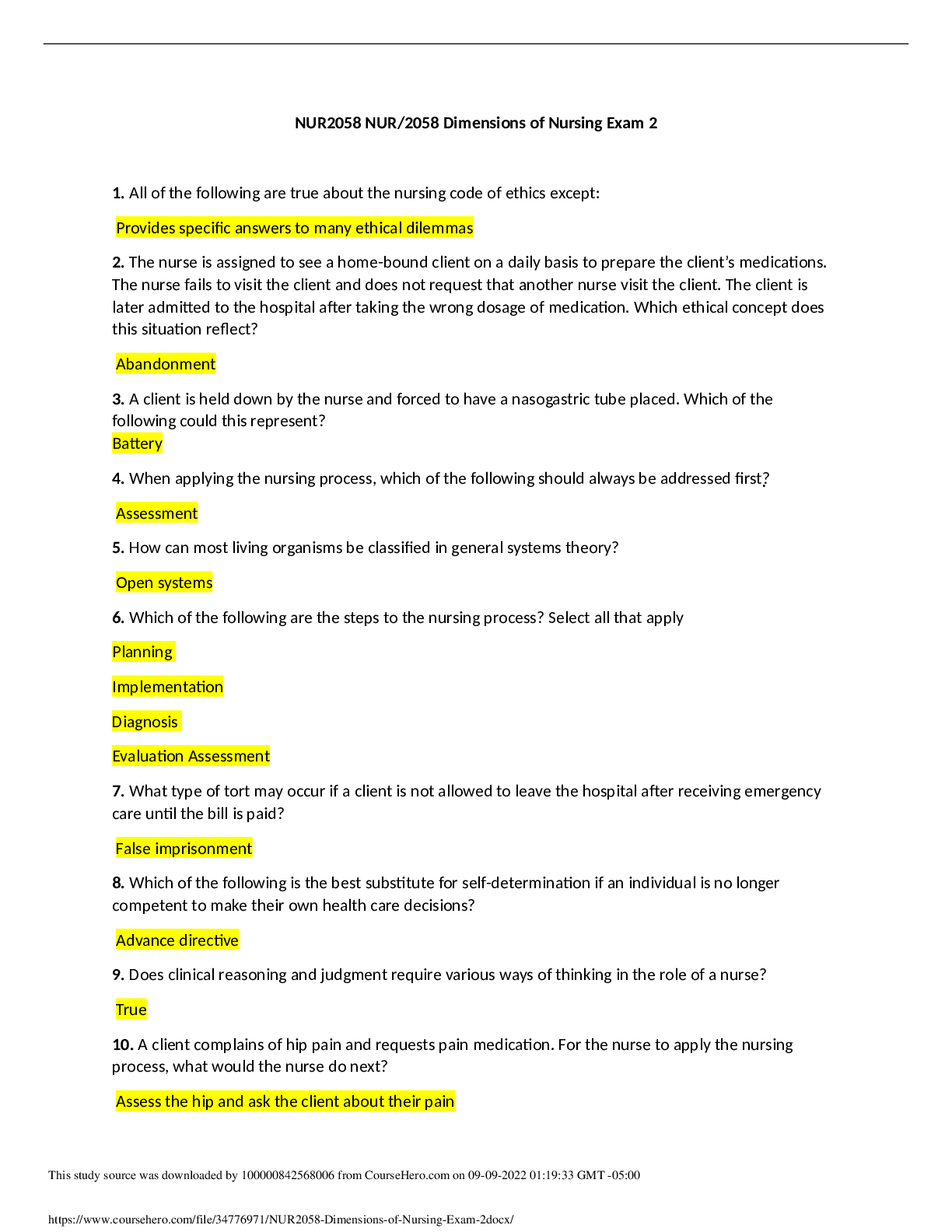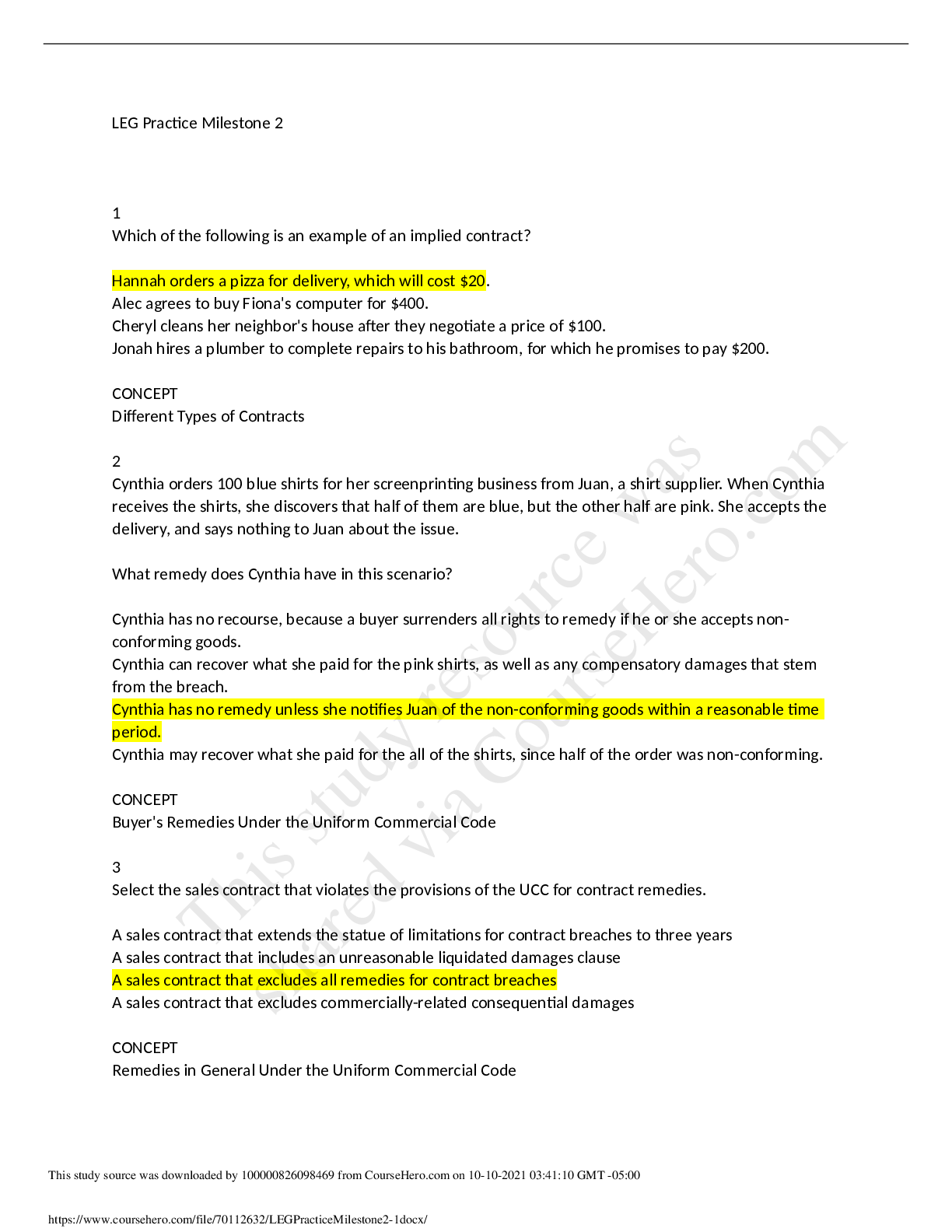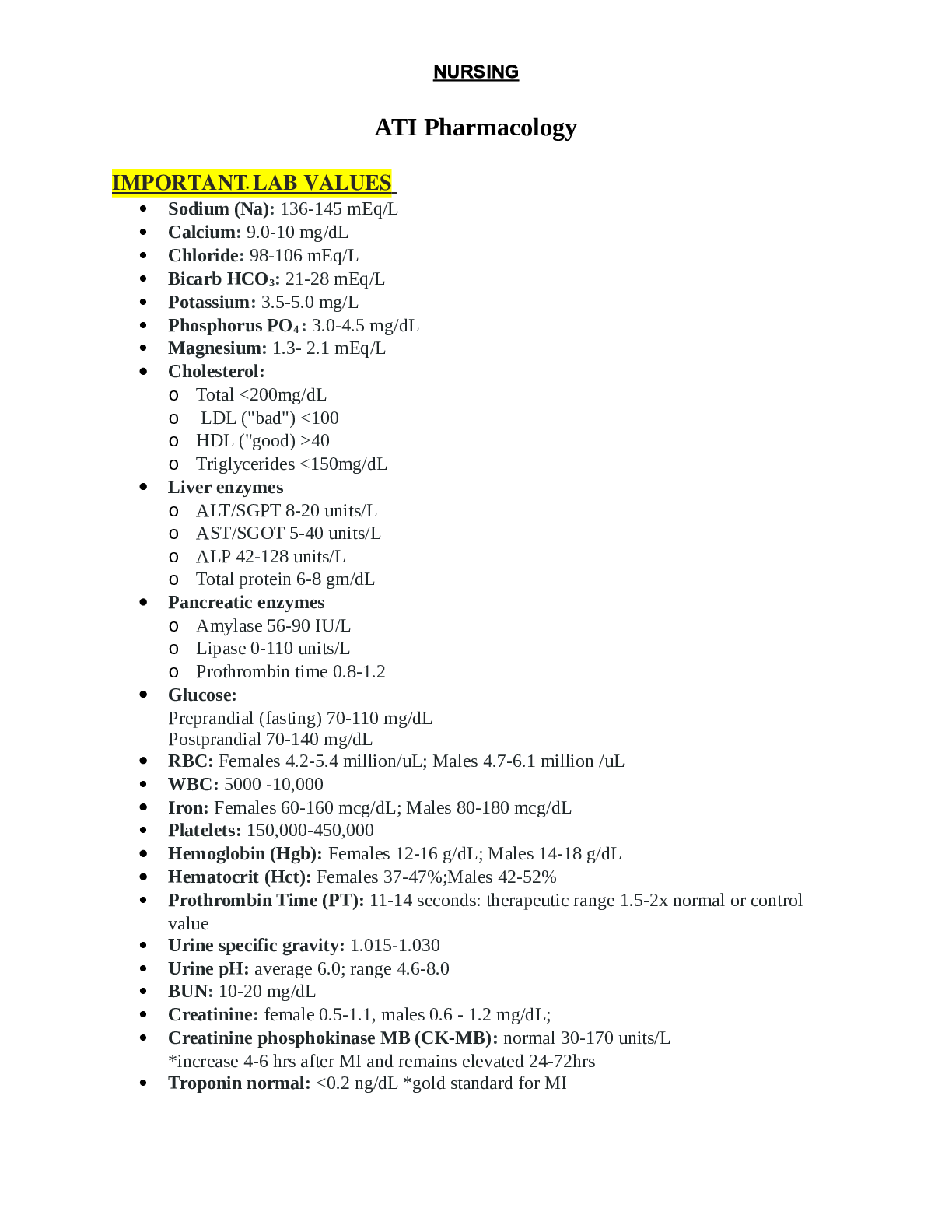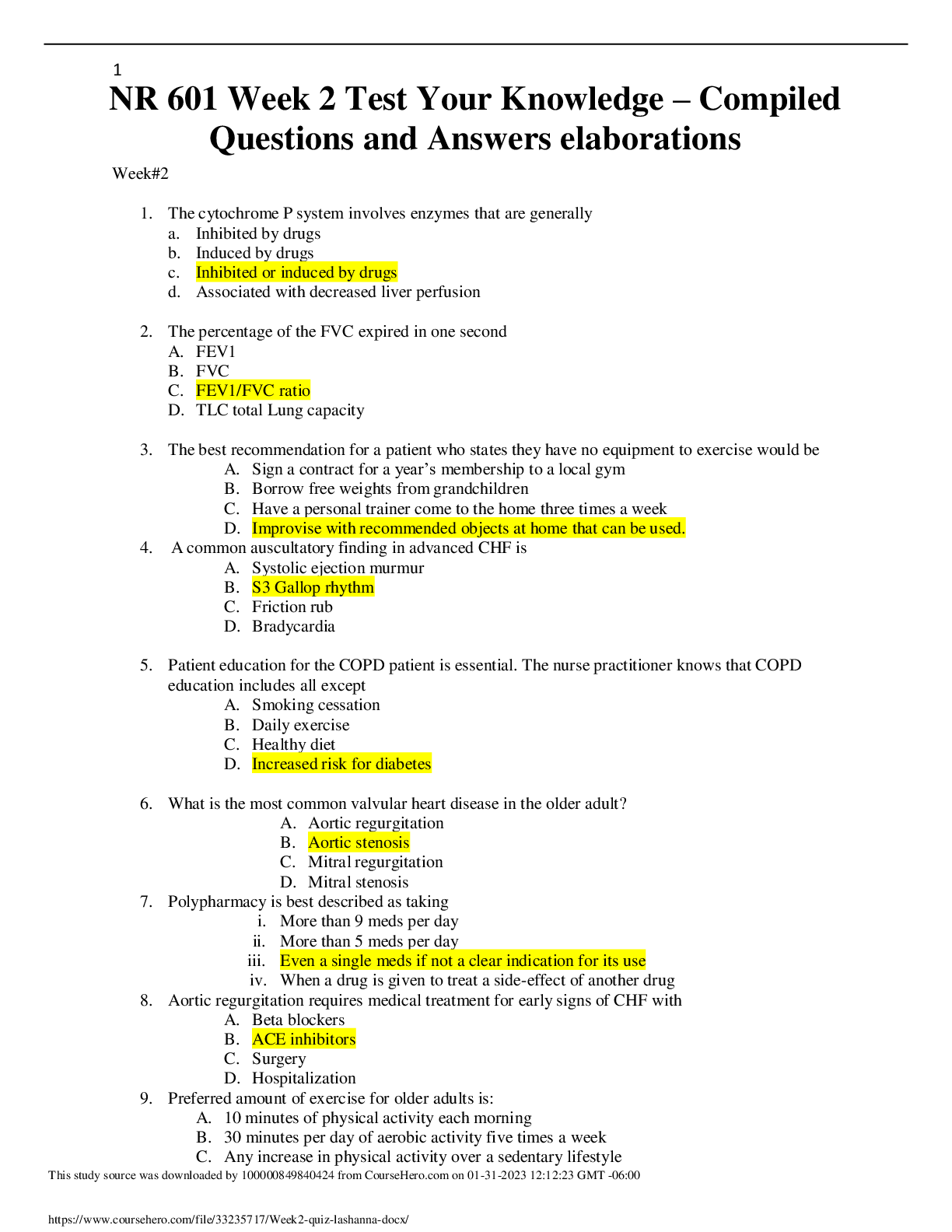*NURSING > EXAM > NURSING 239 Pharm Quiz Assignment HESI Prep Questiona And Answers( Complete Solution+) (All)
NURSING 239 Pharm Quiz Assignment HESI Prep Questiona And Answers( Complete Solution+)
Document Content and Description Below
NURSING 239 Pharm quiz assignment answers 1.ID: 311018725 Which route should the nurse clarify with the healthcare provider prior to administering a drug with a high first-pass effect? A. Int... ravenous. B. Buccal. C. Sublingual. D. Oral. Correct The first-pass effect occurs when hepatic metabolism decreases the bioavailability of a drug. Oral (A) forms of medications are processed through the GI tract, absorbed through the small intestines, and undergo the first-pass effect in the liver before the drug reaches the intended site of action. (B, C, and D) bypass the hepatic metabolism and are not affected by the first-pass effect. Awarded 5.0 points out of 5.0 possible points. 2.ID: 310951980 A client calls the clinic and states that she forgot to take her oral contraceptives for the past two days. Which instruction is best for the nurse to provide to this client? A. Quit the pills for this cycle, use an alternate method of contraception, and resume pills on the fifth day of menstruation. B. Take 4 pills now and use an alternate method of contraception for the rest of this cycle. C. Take 2 pills a day for 2 days and use an alternate method of contraception for 7 days. Correct D. Take one extra pill per day for the rest of this cycle, then resume taking pills as usual next cycle. If two pills are missed the client should implement (A). If three pills are missed, the client should implement (B). The woman who misses three or more days also has the option of stopping the pills in this cycle pack and starting a new pack on the same day. A backup method of contraception should be used for 7 days. (C and D) provide incorrect instructions. 3.ID: 310944033 The healthcare provider prescribes a medication for an older adult client who is complaining of insomnia, and instructs the client to return in two weeks. The nurse should question which prescription? A. Temazepam (Restoril) 7.5 milligrams orally at bedtime. B. Eszopiclone (Lunesta) 10 milligrams orally at bedtime. Correct C. Ramelteon (Rozerem) 8 milligrams orally at bedtime. D. Zolpidem (Ambien) 10 milligrams orally at bedtime. The dosage range for eszopiclone (Lunesta) is 1 to 3 milligrams daily at bedtime, so the dosage for (B) is too high. (A, C, and D) are within a safe dosage range and are not contraindicated for use in the elderly. 4.ID: 310946610 A client with chronic kidney disease (CKD) and severe anemia refuses blood transfusions. The healthcare provider prescribes epoetin alfa. Which action should the nurse explain to the client about the medication's therapeutic response? A. Stimulates erythropoiesis in the bone marrow to increase circulating erythrocytes. Correct B. Accelerates neutrophil production, maturation, and activation. C. Increases production and maturation of granulocytes and macrophages. D. Activates the immune system with development of T and B cells and natural killer cells. Epoetin alfa is a biological response modifier that is used to stimulate the formation of red blood cells (C). (A) describes agents, such as filgrastim, used to decrease the risk for infection in clients with chemotherapy-induced neutropenia. Immunomodulators, a subtype of biologic response modifiers, such as interferon, provide a specified action in the immune system (B) used in chemotherapeutic protocols. (D) specifies the therapeutic response of agents, such as sargramostim, which also inhibits neutrophil migration and is primarily used to accelerate myeloid recovery during bone marrow transplantation. Category: Pharmacology 5.ID: 311002959 Which statement by a client warrants further instruction by the nurse about the changing insulin needs of a diabetic client during pregnancy? A. I will increase my insulin dosage by 5 units each month during the first trimester.Correct B. Breastfeeding will decrease my insulin needs to lower than my prepregnancy levels. C. Insulin dosage will likely need to be increased during the second and third trimesters. Incorrect D. Episodes of hypoglycemia are more likely to occur during the first 3 months. Insulin needs during pregnancy are determined individually according to the client's glucose levels. Insulin needs in the first trimester may actually decrease, so (B) indicates the need for reteaching. (A, C, and D) are correct statements. (A) helps explains why insulin needs may actually decrease in the first trimester. Insulin resistance begins as early as 14- to 16-weeks gestation (C) and continues to rise until it stabilizes during the last few weeks of pregnancy. Insulin needs after birth are lower once the placenta is delivered and the source of insulin resistance is gone. Breastfeeding (D) lowers circulating blood glucose. 6.ID: 310965985 A client receives a new prescription for ciprofloxacin (Cipro), a synthetic quinolone. When teaching about this drug, which information in the client's history requires special emphasis by the nurse? A. Snacks on dairy products such as yogurt or ice cream. B. Works twenty hours a week as a lifeguard at the local pool. Correct C. Previously had a mild allergic reaction to a cephalosporin. D. Consumes alcoholic drinks occasionally on the weekends. Cipro can cause both dizziness and photosensitivity. Since the client works as a lifeguard outdoors (D), measures related to these adverse effects should be addressed. Dairy products (A) do not impact the effectiveness of Cipro. There is no cross-sensitivity between quinolones and cephalosporins (B). Although avoiding alcohol consumption is commonly recommended with many prescription drugs, (C) does not affect the actions of Cipro. 7.ID: 310944037 Which common side effect should the nurse alert a female client about when medroxyprogesterone (Depo-Provera) is prescribed? A. Leg or calf pain. Incorrect B. Jaundice during the first 3 weeks of administration. C. Headaches or visual changes. D. Vaginal bleeding after discontinuing the medication. Correct Approximately 3 to 7 days after the last cyclic dose of medroxyprogesterone, a female client may experience withdrawal vaginal bleeding (C). (A, B, and D) are not common side effects of hormonal therapy and may indicate a serious adverse reaction. 8.ID: 310993907 When assessing a client prior to the administration of digoxin (Lanoxin), which data is most important for the nurse to consider? A. Bilateral lower extremity dependent rubor. B. Presence of a grade 2 murmur. C. Nailbed capillary refill of 5 seconds. D. Irregular apical pulse with a rate of 87. Correct The action of digoxin is to slow the heart rate and strengthen the force of contraction, so it is essential for the nurse to ensure that the apical pulse (C) is within determined parameters prior to administration. (A, B, and D) are unlikely to influence the nurse's decision regarding the administration of digoxin. 9.ID: 310993979 A client is receiving fentanyl via an epidural infusion. Which side effect should the nurse anticipate in the first 24 hours of epidural analgesia? A. Urinary retention. Correct B. Headache. C. Abdominal cramping and diarrhea. D. Agitation. Common side effects of epidural opioids include nausea, itching, and urinary retention (C), which may require urinary catheterization. Headache (A), fever, altered mental status, or agitation (B) are more likely indicative of acute bacterial infection caused by an epidural catheter that has been in place longer than 24 hours. Other complications may include catheter displacement and migration, but (D) is not related to epidural administration of fentanyl. 10.ID: 310957489 A resident of a long-term care facility is taking lithium carbonate (Eskalith) to treat bipolar disorder. Which instruction should the nurse provide to this client's caregivers? A. Report symptoms of hypothyroidism such as fatigue and constipation. Correct B. Encourage high energy fluid intake by providing sports drinks or sodas. C. Have the client chew the pill if it is difficult to swallow. D. Offer the morning dose of the medicine before breakfast. Lithium carbonate (Eskalith) causes hypothyroidism in 1 to 4% of those clients receiving the medication, so caregivers should assess for signs of hypothyroidism, including fatigue and constipation (early signs) and myxedema or goiter (late symptoms) (D). Lithium carbonate (Eskalith) should be offered with meals, not before (A), and should not be chewed, crushed, or halved (B). Fluid intake should be encouraged to treat polydipsia caused by this medication, but (C) should be avoided to reduce the occurrence of weight gain and dental caries. 11.ID: 310945266 An emergency department triage nurse is interviewing a female client who has a history of epilepsy with tonic-clonic seizures controlled by phenytoin (Dilantin). Which information is most significant in planning this client's care? A. She has had no dental care for several years. B. She has smoked 3 packs of cigarettes a day for 10 years. C. She has missed 2 menstrual periods. D. She ran out of her medication 4 days ago. Correct Abruptly stopping anticonvulsant medications can precipitate seizures or the development of status epilepticus (C). Immediate seizure precautions and medication administration are necessary. (B) can contribute to gingival hyperplasia, but this problem does not have the priority of (C). (A) may cause an alteration in her seizure activity or medication needs, but a pregnancy is not yet confirmed and the drug withdrawal is known. Though (D) is an unhealthy habit, it does not increase the likelihood of seizure activity. 12.ID: 310972783 An elderly client is admitted with suspected bacterial pneumonia and lethargy. Ten minutes after the nurse initiates low-flow oxygen per nasal cannula and a peripheral IV with a secondary infusion of ticarcillin (Ticar), the client becomes disoriented, restless, and tachypneic. Which nursing action has the highest priority? A. Observe the client's trunk and back for any hives and ask about the onset of urticaria. B. Call for the emergency resuscitation team and retrieve the unit's crash cart. C. Notify the healthcare provider and prepare to administer IV diphenhydramine (Benadryl). D. Stop the IV piggyback infusion and increase the oxygen flow to 3 L/minute.Correct The client's symptoms depict the onset of an anaphylactic reaction to ticarcillin, an extended-spectrum penicillin, so the priority nursing actions include halting the client's exposure to the medication and supporting breathing efforts (B). (A, C, and D) are important interventions that should occur immediately after (B) is implemented. Category: Pharmacology 13.ID: 311018759 The healthcare provider prescribes pyridostigmine bromide (Mestinon) tablets for a client with myasthenia gravis (MG). What instruction should the nurse provide this client? A. Take the medication 30 to 45 minutes before eating. Correct B. Give the client a dietary guide that describes low-protein foods. C. Increase activity in the afternoon when the medication is most effective. D. Use a PRN dose for increasing muscular weakness or fasciculations. Mestinon, an acetylcholinesterase inhibitor, increases the amount of neuromuscular transmitters to promote muscular strength and swallowing, so the client should take the medication at least 30 minutes before meals (B). Activity should be scheduled in the mornings and after drug administration (A) when therapeutic responses peak. (C) may reflect either under-dosing or over-dosing and requires differential diagnosis by the healthcare provider. A low-protein diet (D) is not part of the treatment protocol for MG. 14.ID: 310945276 A female client receives a prescription for cefadroxil (Duricef) for a urinary tract infection. The client informs the nurse that she is currently taking oral contraceptives (OCP). What information is important for the nurse to share with the client? A. Avoid prolonged sun exposure while taking the antibiotic. B. Use an additional form of contraception until your menstrual cycle. Correct C. The antibiotic may be less effective while taking OCP. D. The medication combination potentiates the risk of adverse reactions. Cephlasporins such as cefadroxil can decrease the efficacy of oral contraceptives, so the client should be instructed to use an additional form of contraceptive (D). (A and B) are inaccurate. (C) is not related to the administration of cephlasporins and OCPs. 15.ID: 310944025 Miotic drug therapy for the treatment of glaucoma is based chiefly upon which physiologic action? A. Inhibiting aqueous humor production. B. Enhancing aqueous humor outflow. Correct C. Preventing extraocular infection. D. Maintaining intraocular pressure. Miotic drugs act to enhance aqueous outflow through papillary constriction (A). Beta-blockers are used to inhibit aqueous humor production (B). The goal is to reduce intraocular pressure, not (C). (D) is not an action of these drugs. 16.ID: 310945782 The mother of a newborn asks the nurse why her infant needs the vitamin K (AquaMEPHYTON) injection. What information should the nurse provide? A. The synthesis of vitamin K is inadequate for 3 to 4 months in the newborn. B. Oral vitamin K impedes the synthesis of clotting factors in the liver. C. Bacteria that synthesize vitamin K are not present in the newborn's intestinal tract. Correct D. The maternal diet is often deficient in vitamin K, so the infant is deficient in the vitamin. Vitamin K is provided because the newborn does not have the intestinal flora to synthesize adequate vitamin K in the intestines (A). Vitamin K promotes the formation of clotting factors in the liver, not (B), and is routinely given by injection to prevent or treat hemorrhagic disease in the newborn. The maternal diet (C) does not significantly affect the amount of vitamin K in the newborn. By day 8, newborns are able to produce their own vitamin K, so (D) is inaccurate. Awarded 17.ID: 310965987 A client receives a new prescription for nitroglycerin (Nitrostat) tablets. Which instruction should the nurse include in this client's teaching? A. Resume normal activities after chest pain relief is obtained. B. Take the medication at least an hour before every meal. C. Monitor your pulse for 60 seconds before administration. D. Place under the tongue as needed every 5 minutes up to 3 times. Correct The client should be instructed to place a tablet under the tongue every 5 minutes up to 3 times (C), and call 911 if the anginal pain is not relieved. Nitrostat tablets should be taken sublingually (SL), under the tongue, to avoid first-pass effect, so oral administration (A) is not indicated. The nitroglycerin should be taken at the onset of chest pain without delay (B) to expedite oxygen flow to myocardial tissues. Nitroglycerin is a vasodilator, so the client should be instructed to rest (D) and rise slowly after administration to avoid orthostatic hypotension. 18.ID: 310944524 Which client requires the most immediate intervention by the nurse? A. A client with low back pain who is experiencing tolerance to the effects of an analgesic. B. An adolescent with a history of drug addiction who is requesting a sedative. C. A client with a chronic renal disease who is demonstrating a therapeutic response to a diuretic. D. A young adult who is reporting an anaphylactic response to an antibiotic.Correct An anaphylactic response (D) is a severe allergic reaction that may result in airway constriction and shock, so the nurse should first respond to this potentially life-threatening situation. Drug tolerance (A) occurs when there is a decreased physiological response after repeated administration of a drug, so the client may be experiencing pain, but this is of less priority than (D). Possible drug-seeking behaviors (B) and diuresis, the therapeutic response to a diuretic (C), require intervention by the nurse but are of less priority than (D). Category: Pharmacology 19.ID: 310946644 The nurse is providing medication teaching for a client who has recently received a prescription for clozapine (Clozaril). Which instruction should be included in this client's teaching plan? A. Rise slowly from a lying position. Correct B. Do not eat any aged cheese. C. Avoid prolonged sun exposure. D. Take as needed for anxiety. Orthostatic hypotension is a side effect of Clozaril, so the client should be instructed to rise slowly from a lying position (B). Sun exposure (A) should be avoided by those taking phenothiazines. Eating aged cheeses (C) is a dietary restriction for those who are taking MAO inhibitors. Clozaril is an antipsychotic medication that is taken daily, not taken on an as needed basis (D). 20.ID: 311023677 A client receives a prescription for sulfamethoxazole-trimethoprim (Septra) for a urinary tract infection (UTI). What instruction should the nurse provide the client? A. Avoid prolonged exposure to sunlight. Incorrect B. Ingest food prior to taking the antibiotic.amit C. Drink at least 8 glasses of water a day. Correct D. Take the medication with grapefruit juice. To decrease the risk of renal damage due to crystalluria associated with sulfamethoxazole, the client should be instructed to consume at least 8 glass of water a day (B). To increase absorption, sulfamethoxazole should be given on an empty stomach, not (A). (C and D) are not indicated for Septra. 1.ID: 310945774 What pathophysiological action supports the expected outcome for a client with chronic cancer pain who is treated with imipramine (Tofranil), a tricyclic antidepressant? A. Increases pain threshold by stimulating opiate receptors in the CNS to release of endogenous enkephalins. B. Increases pain tolerance through relief of depression by increasing the amounts of norepinephrine in the brain. C. Decreases transmission of pain impulses by altering serotonin and norepinephrine activity at nerve synapses. Correct D. Decreases perception of pain by blocking opiate receptors in the brain and descending inhibitory nerves. Incorrect Tricyclic antidepressants reduce neuropathic pain due to cancer invasion by blocking the reuptake of serotonin and norepinephrine in the CNS, and thereby inhibit pain transmission (C) in the spinal cord dorsal horn, which are part of the descending pain-modulating system. (A, B, and D) do not describe the effectiveness of tricyclic antidepressants in pain management. 2.ID: 310993903 A 38-year-old gravida 2 para 2 is diagnosed with bacterial vaginosis 9-months postpartum. A prescription is written for metronidazole (Flagyl). Which information is most important for the nurse to obtain from the client before initiating treatment? A. Sexual history. B. Use of oral contraceptives. C. Possibility of pregnancy. D. Method of infant feeding. Correct Flagyl is contraindicated if the woman is breastfeeding (C) because high concentrations have been found in infants. If Flagyl must be prescribed, the woman should be instructed to pump and discard the milk during treatment and for 48 to 72 hours after the last dose. (A, B, and D) provide important assessment data but are of less priority than (C). Flagyl was formerly contraindicated in the first trimester. However, because of the incidence of preterm birth related to bacterial vaginosis , the CDC now recommends treatment of all asymptomatic and symptomatic clients unless Flagyl is contraindicated for other health reasons. 3.ID: 310953499 A client receives a prescription for esomeprazole (Nexium) for heartburn. Which finding in the client's history should the nurse report to the healthcare provider before administering the prescription? A. Eats spicy food three times a week. B. History of deep vein thrombosis. Correct C. Family history of diabetes mellitus. D. Drinks 2 alcoholic beverages on weekends. Esomeprazole (Nexium), a proton pump inhibitor (PPI), may increase the chance of bleeding in a client who is taking both a PPI and warfarin (Coumadin), which is used in the treatment of deep vein thrombosis (DVT). The healthcare provider should be informed of the client's recent history and treatment for DVT (B) prior to giving Nexium. The client should minimize intake of spicy foods (A) and alcohol (C), which contribute to heartburn, but do not interact with Nexium. The client's family history of diabetes (D) is unrelated to the use of Nexium. 4.ID: 310969493 The healthcare provider prescribes oral antifungal therapy for a client with onychomycosis. What information should the nurse tell the client? A. Prolonged therapy provides no benefit and increases the risk of adverse effects. B. A single dose of the oral antifungal agent is usually sufficient to treat the infection. C. The infection is difficult to eradicate and requires prolonged therapy for 3 to 6 months. Correct D. Complete eradicate is important because of the risk of a systemic infection. Treatment of onychomycosis, a fungal infection of the fingernails and toenails, is difficult to treat and requires prolonged therapy of 3 to 6 months (B) for oral antifungal therapy. (A, C, and D) provide incorrect information. 5.ID: 310945270 What action should the nurse implement to provide analgesic titration for a client in pain? A. Plan with the client how to use a specific total dose of analgesic over a 24-hour B. . C. Monitor the effects of continuous intravenous infusion of narcotic analgesics. D. Teach the client to increase the time range between doses of pain medication. E. Determine the optimal analgesic dosage required that causes the least side effects. Correct No given dosage of an analgesic provides the same level of pain relief for every patient, and so titration upward or downward is determined based on the client's response, so that the optimal dosage achieves adequate pain relief with minimal side effects (D) for the client. Titration does not necessarily mean continuous intravenous infusion (B), but considers dose adjustments to achieve a therapeutic analgesic response. An individual's response to the medication dosage is the assessment for titration, not a specific total dose over 24 hours (C). Although (A) may be a component of pain management, particularly during rehabilitation or remission, the titration dose should be implemented as long as analgesia is needed. 6.ID: 311028903 Which client data is most important for the nurse to obtain prior to beginning a client's blood transfusion of packed red blood cells? A. Weight. B. Skin turgor. C. Oxygen saturation. D. Vital signs. Correct Baseline vital signs (D) are essential to obtain prior to administering a blood transfusion, so that vital signs measured during the transfusion administration can be compared to the baseline to assess for the onset of a transfusion reaction. (A, B, and C) provide less significant data immediately prior to the administration of the transfusion. Category: Pharmacology 9.ID: 310969415 A client with pneumonia receives a prescription for tetracycline (Sumycin). What precaution should the nurse include in this client's teaching? A. Do not use teeth whitening agents during the treatment regimen. B. Take the medication with a glass of orange juice. C. Avoid diary products for 2 hours after taking the medication. Correct D. Avoid over-the-counter medications containing alcohol. Dairy products should be ingested at least 2 hours after taking Sumycin (C) because calcium binds with tetracycline and decreases its absorption. Sumycin can be taken with orange juice (A) because it does not affect absorption of the medication. Sumycin does not cause a disulfiram-like reaction, so (B) is not indicated. Although Sumycin causes enamel hypoplasia and permanent yellow, gray, or brown staining of the teeth during the ages of tooth development (children younger than 8 years of age), it does not affect adult enamel, so (D) is not indicated. Awarded 12.ID: 310978693 The nurse should expect the healthcare provider to prescribed what treatment regimen for a client with peptic ulcer caused by Helicobacter pylori? (Select all that apply.) A. Clarithromycin (Biaxin). Correct B. Misoprostol (Cytotec). C. Sulfisoxazole (Gantrisin). D. Omeprazole (Prilosec). Correct E. Metronidazole (Flagyl). Correct F. Sucralfate (Carafate). Recommended medical treatment for Helicobacter pylori includes the use of at least 2 different antibiotics and a proton pump inhibitor to decrease the incidence of antibiotic resistance, so (A, D, and E) are consistent with this protocol. (B, C, and F) are ineffective. 13.ID: 310972707 A client who has been taking a diuretic and ACE inhibitor for hypertension has a blood pressure of 160/90. Today a new drug, carvedilol (Coreg), is prescribed, and the client expresses concern about receiving so many different medications. What action should the nurse implement? A. Document the client's BP and refusal to take the newly prescribed medication. B. Withhold the newly prescribed medication until contacting the healthcare provider. C. Administer the newly prescribed medication and withhold the other two medications. D. Explain the rationale for the administration of all three medications to the client. Correct Treatment of hypertension may require a combination of several different medications, so the nurse should explain the rationale for the use of three different types of medications (A), thus addressing the client's expressed concern. Since the client's BP is elevated there is no indication that any of the prescribed medications (B and C) should be withheld. The client has expressed concern, not refusal to comply with treatment (D). Category: Pharmacology 14.ID: 310944039 The nurse is assessing a client with a ruptured small bowel and determines that the client has a temperature of 102.8° F. Which assessment finding provides the earliest indication that the client is experiencing septic shock? A. Mucus production. B. Bilateral crackles. C. Hyperpnea. Correct D. Weak peripheral pulses. The interrelated pathophysiologic changes associated with the hypermetabolic state of sepsis and septic shock produce a pathologic imbalance between cellular oxygen demand, supply, and consumption. Hyperpnea (B), an increased depth of respirations, is an early manifestation of sepsis. (A, C, and D) are signs of advanced shock. 15.ID: 311023635 A client with depression receives a prescription for amitriptyline (Elavil). Which instruction should the nurse include in the client's teaching? A. Obtain daily blood pressure readings. B. Avoid the consumption of alcohol. Correct C. Do not ingest foods with tyramine. D. Take with a glass of orange juice. Tricyclic antidepressants (TCAs) such as amitriptyline can cause sedation and should not be mixed with agents that depress the central nervous system, so the client should be instructed to avoid alcohol (B). Tyramine rich foods (A) should be avoided when taking mono-amine oxidase inhibitors. Blood pressure (C) should be monitored in a client taking selective-serotonin reuptake inhibitors. (D) does not affect the absorption of amitriptyline. 16.ID: 311002947 A client is diagnosed with peptic ulcer disease and receives a prescription for esomeprazole (Nexium) 20 mg capsule daily. When providing this client with discharge teaching, the nurse should include which instruction? A. Monitor for an increase in blood pressure during therapy. B. Dissolve capsule contents in fruit juice for easier ingestion. C. Drink fluids between meals to relieve gastric distress. D. Take at same time each day one hour before eating a meal. Correct Nexium, a proton pump inhibitor (PPI), is a first-line agent for symptomatic GERD that poorly responds to other acid reducing drugs, such as H2 antagonists. Nexium is most effective when taken 30 to 60 minutes before a meal (D). Although liberal fluid intake helps to dilute gastric acidity (A), it is not necessary to ensure the effectiveness of Nexium. Common side effects may include headache or light-headedness, but blood pressure is usually not affected (B). Nexium capsules can be opened, but the delayed-release granules should not be chewed or dissolved (C) before ingesting. 17.ID: 310985647 A pediatric client who has been diagnosed with partial seizures receives a prescription for topiramate (Topamax). What information should the nurse provide to the child's parents? A. Avoid prolonged exposure to direct sunlight. B. Administer the tablet an hour before meals. C. Do not crush the tablet prior to administration. Correct D. Give the medication with 8 oz of orange juice. The tablet form of topiramate should be taken with adequate fluids and without breaking it because of its extremely bitter taste, so crushing the tablet (A) should be avoided. (B and D) do not affect the mechanism of action of topiramate. Avoiding prolonged exposure to sunlight (C) is recommended to prevent sunburn, but topiramate does not cause an exaggerated photosensitive reaction. 18.ID: 310982305 Which findings should the nurse identify in an adult client with possible chronic salicylate intoxication? A. Hyperventilation and central nervous system effects. B. Photosensitivity and nervousness. C. Tinnitus and hearing loss. Correct D. Acute gastrointestinal bleeding and anorexia. The most frequent manifestations of chronic salicylate intoxication in adults are tinnitus and hearing loss (A). Photosensitivity and nervousness (B) are not common sign effects of salicylate intoxication. Although GI bleeding (C) is a side effect of long-term use of aspirin, it is not a manifestation of toxicity. Hyperventilation and central nervous system effects (D) are most frequently seen in children. 19.ID: 310962773 A client receives a new prescription for pentazocine (Talwin), a mixed opioid agonist-antagonist, after an opioid agonist is discontinued. What is the advantage for the client when the new prescription is implemented? A. Respiratory depression is less. Correct B. Tolerance does not occur. C. Less agitation is experienced. D. The analgesic ceiling is higher. Mixed agonist-antagonists bind as an agonist at the Kappa receptor and as antagonists or partial agonists on the mu receptor, which produces less respiratory depression (D) than opioid agonists that are pure mu agonists. (A, B, and C) do not occur. 20.ID: 310944096 A client is taking sulfisoxazole (Gantrisin) for a urinary tract infection (UTI) and complains of nausea and gastric upset since starting the medication. Which additional adverse reaction should the nurse instruct the client to report? A. Rash. Correct B. Diarrhea. Incorrect C. Muscle cramping. D. Hematuria. Side effects of sulfisoxazole (Gantrisin), a sulfonamide antibiotic, include possible allergic response, manifested by skin rash (A) and itching, which can progress to Stevens-Johnson syndrome - erythema multiforme, a severe hypersensitivity reaction. Other gastrointestinal disturbances, such as diarrhea (B), crystalluria and photosensitivity are other side effects that commonly occur with sulfa agents but do not need the discontinuation of the prescription. Hematuria (C) is associated with a UTI. Muscle cramping (D) is mostly likely related to an electrolyte disturbance. 19.ID: 310989357 The healthcare provider has prescribed digoxin for a client who has been taking furosemide (Lasix) for six months. What laboratory serum levels should the nurse review before administering the digoxin? A. Magnesium. B. Furosemide. C. Calcium. D. Potassium. Correct The client's serum potassium levels (C) should be evaluated before giving the first dose of digoxin because Lasix is can cause hypokalemia and increase the risk of digoxin toxicity and cardiac arrhythmias. Although Lasix can increase urinary excretion of (A and B), these serum electrolytes do not impact the concomitant use with digoxin, as does potassium. There is no serum drug level for furosemide (D). 18.ID: 310944031 A client who is recently diagnosed with myasthenia gravis receives a prescription for pyridostigmine (Mestinon), a cholinergic agent. Which information should the nurse instruct the client to implement when taking this medication? A. Plan the doses close together for maximal therapeutic effect. B. Avoid dairy products two hours before and after taking medications. C. Always take with meals to avoid gastrointestinal distress. Incorrect D. Take the medication atleast 30 minutes before eating meals. Correct The nurse should instruct the client to take the medication 30 minutes before meals (C), which allows for the onset of action and therapeutic effects during the meal to improve swallowing and chewing. The doses should be spaced evenly apart to optimize the effects of the medication, not (A or B). (D) is not indicated. 15.ID: 311018775 The healthcare provider discontinues prednisone, a glucocorticoid, for a client with chronic obstructive pulmonary disease. What instructions should the nurse give the client about the regimen to follow? A. Life-long treatment is common for chronic disease. B. The dose must be tapered over the course of 7 to 10 days. Correct C. Another glucocorticoid should be used to prevent cross-tolerance. D. The drug should be stopped immediately if no longer needed. To minimize the impact of adrenal insufficiency, withdrawal of exogenous glucocorticoids should be done by gradually decreasing the dosage over several days (C). Prolonged treatment with a glucocorticoid is not indicated for life (A) and can cause life-threatening adrenal insufficiency if abruptly terminated (B). Tapering the dosage should be done rather than substituting another glucocorticoid (D). 14.ID: 310945242 The nurse administers dopamine (Intropin) IV infusion at 3 mcg/kg/min to a critically ill, hypotensive client. What is the intended effect of this treatment? To increase A. urine output to 55 ml/hr. Correct B. blood pressure to 140/80. C. respirations to 24 breaths/min. D. pulse to 132 beats/min. The expected outcome of this treatment is an increase in urine output due to increased renal perfusion (B). Dopamine, a catecholamine, provides renal and mesenteric vasodilation at a low dosage level, such as the 3 mcg/kg/minute infusion that was prescribed for this client. A higher dose of dopamine is needed to affect (A or C) to the levels indicated in a critically ill client who is hypotensive. (D)'s effect would be minimal. Category: Pharmacology 13.ID: 310947622 A male client who is in the terminal stage of cancer is cared for at home by his family and receives a prescription for morphine at a rate to control intractable pain. When the hospice nurse visits, the client awakens, moans in severe pain, and asks for an increase in the morphine dosage. After determining the client's respirations are 10 per minute, what is the best action for the nurse to implement? A. Hold additional morphine until the client's respirations are at least 16 per minute. B. Titrate the morphine dose upward until the client has adequate pain relief. Correct C. Inform the client that an increased dose of morphine increases side effects without additional pain control. D. Suggest to the family that they can also give the client ibuprofen, a non-narcotic analgesic. Incorrect Tolerance can occur in a client who requires large doses of opioids for intractable pain management, and an increased titration of the analgesic (A) or an additional drug in the same or a different classification may provide more effective pain management. (B) offers an ineffective choice for intractable pain control. (C and D) do not address the client's basic need for comfort during the last stages of a terminal malignancy. Awarded 12.ID: 310944029 What is the effect of beta-blocking agents when used for treatment of glaucoma? A. Inhibiting aqueous humor production. Correct B. Preventing extraocular infection. C. Increasing intraocular pressure. D. Enhancing aqueous humor outflow. Beta-blockers are used to inhibit aqueous humor production (A). (B) is the action of miotic drugs for glaucoma. The goal is to reduce intraocular pressure, not increase it (C). (D) is not an action of these drugs. 9.ID: 310944041 The nurse should withhold which medication if a client reports nausea and vomiting, and diarrhea? A. Colchicine (Colchicine). Correct B. Labetolol (Normodyne). C. Naproxen (Aleve, Naprosyn). D. Erythromycin (E-Mycin). Nausea, vomiting, and diarrhea are indicators of toxic effects of colchicine (A), which can be life-threatening, and if present, this drug should be withheld and the healthcare provider notified. While nausea, vomiting, and diarrhea are common side effects of (B, C, and D), these drugs do not need to be withheld. 8.ID: 310978621 A client who has Trichomonas vaginalis receives a prescription for metronidazole (Flagyl). Which instruction should the nurse provide during client education? A. Notify the clinic if the urine changes color. Incorrect B. Do not ingest with diary products. C. Avoid over-the-counter antitussives. Correct D. Obtain liver function tests every 3 months. Flagyl can produce a disulfiram (Antabuse)-like reaction when combined with products containing alcohol, such as over-the-counter cough remedies, so the client should be informed to avoid ingesting any alcohol product during the use of Flagyl (D). To decrease gastrointestinal irritation, the medication can be taken with diary products, not (A). Changes in the color of urine is an expected side effect, so the client does not need to notify the clinic (B). Flagyl can cause falsely elevated liver function tests (C), so the client's laboratory results for liver function should consider the current use of this medication. • 5.ID: 310959887 The nurse administers the initial dose of a fentanyl (Duragesic) transdermal patch to a client with chronic pain. When monitoring the client an hour later, which assessment is most important for the nurse to obtain? A. Moistness of mucosa. B. Level of consciousness. C. Bowel sound activity. D. Numeric pain scale. Correct Transdermal fentanyl, an opioid analgesic, has an onset and peak of 6 to 12 hours after the initial dose, so it is most important to determine the client's level of pain (D), which can persist as breakthrough pain throughout the 72-hour duration of the patch. Although opioids cause CNS depression (A), the cumulative effects of analgesics should be monitored based on the route of absorption and other client variables. (B and C) identify other responses to opiates, but are of less priority than assessing for pain. Awarded 5.0 points out of 5.0 possible points. Page 5 of 20 4.ID: 311023607 A client who is diagnosed with methillicin-resistant Staphylococcus aureus receives a prescription for vancomycin (Vancocin). Which assessment should the nurse perform to identify a potential adverse effect? A. Whisper test. Correct B. Skin turgor. C. Tactile discrimination. D. Romberg test. The most serious adverse effect of vancomycin is ototoxicity, which often causes irreversible, permanent impairment. So, a whisper test (A) determines the presence of early hearing impairment. Romberg test (B) assesses balance of the client. Tactile discrimination (C) determines the presence of peripheral neuropathy. (D) assesses for dehydration. Awarded 5.0 points out of 5.0 possible points. 3.ID: 310985657 The nurse should instruct a client to avoid which product while taking carisoprodol (Soma) for muscle spasms? A. Antacids. B. Aspirin products. C. Dairy products. D. Alcoholic beverages. Correct Soma is a centrally-acting muscle relaxant that can cause CNS depression, and can have an additive effect when taken with other CNS depressants, such as alcohol (C). There are no contraindications to the concurrent use of (A, B, or D) with Soma. 2.ID: 311023625 What teaching should the nurse provide a client who has received a new prescription for sildenafil (Viagra)? (Select all that apply.) A. Report rebound priapism that occurs for 4 hours or more. Correct B. Most effective if taken after at least 6 hours of REM sleep. C. Frequent use can lead to the development of hypertension. D. Can cause facial flushing and headache. Correct E. Take within 30 to 60 minutes of sexual stimulation. Correct Correct answers are (C, D, and E). Sildenafil (Viagra) enhances the natural response to sexual stimuli, so a client should be instructed to take Viagra within 30 to 60 minutes before sexual intercourse to provide adequate time to enhance penile erection (C). Sildenafil does not cause erection directly, but priapism (D) can occur and should be reported to the healthcare provider if it persists. Common side effects include headaches, facial flushing (E), and diarrhea. Although adequate sleep is advantageous for sexual performance, Viagra's effectiveness is not dependent on (B). Viagra can potentiate vasodilators, such as alpha-adrenergic blockers, nitroglycerin, and other nitrates used for angina pectoris, and may cause hypotension, not (A), which decreases perfusion to vital organs. [Show More]
Last updated: 1 year ago
Preview 1 out of 17 pages
Instant download
.png)
Buy this document to get the full access instantly
Instant Download Access after purchase
Add to cartInstant download
Reviews( 0 )
Document information
Connected school, study & course
About the document
Uploaded On
Jan 26, 2021
Number of pages
17
Written in
Additional information
This document has been written for:
Uploaded
Jan 26, 2021
Downloads
0
Views
48

